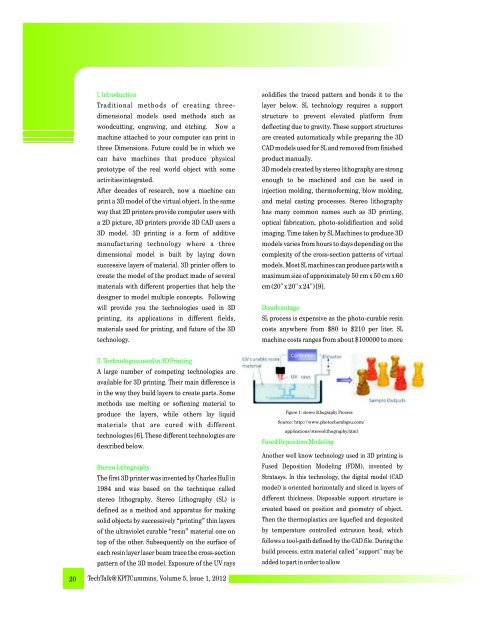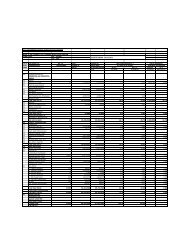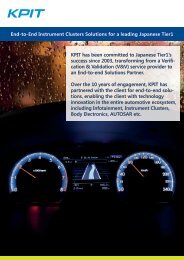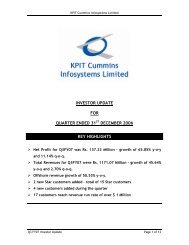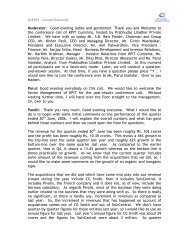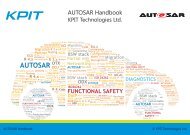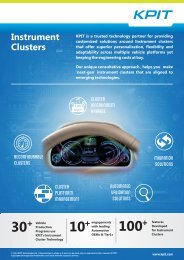INNOVATIONS FROM THE EDGE - KPIT
INNOVATIONS FROM THE EDGE - KPIT
INNOVATIONS FROM THE EDGE - KPIT
Create successful ePaper yourself
Turn your PDF publications into a flip-book with our unique Google optimized e-Paper software.
I. Introduction<br />
Traditional methods of creating threedimensional<br />
models used methods such as<br />
woodcutting, engraving, and etching. Now a<br />
machine attached to your computer can print in<br />
three Dimensions. Future could be in which we<br />
can have machines that produce physical<br />
prototype of the real world object with some<br />
activities integrated.<br />
After decades of research, now a machine can<br />
print a 3D model of the virtual object. In the same<br />
way that 2D printers provide computer users with<br />
a 2D picture, 3D printers provide 3D CAD users a<br />
3D model. 3D printing is a form of additive<br />
manufacturing technology where a three<br />
dimensional model is built by laying down<br />
successive layers of material. 3D printer offers to<br />
create the model of the product made of several<br />
materials with different properties that help the<br />
designer to model multiple concepts. Following<br />
will provide you the technologies used in 3D<br />
printing, its applications in different fields,<br />
materials used for printing, and future of the 3D<br />
technology.<br />
solidifies the traced pattern and bonds it to the<br />
layer below. SL technology requires a support<br />
structure to prevent elevated platform from<br />
deflecting due to gravity. These support structures<br />
are created automatically while preparing the 3D<br />
CAD models used for SL and removed from finished<br />
product manually.<br />
3D models created by stereo lithography are strong<br />
enough to be machined and can be used in<br />
injection molding, thermoforming, blow molding,<br />
and metal casting processes. Stereo lithography<br />
has many common names such as 3D printing,<br />
optical fabrication, photo-solidification and solid<br />
imaging. Time taken by SL Machines to produce 3D<br />
models varies from hours to days depending on the<br />
complexity of the cross-section patterns of virtual<br />
models. Most SL machines can produce parts with a<br />
maximum size of approximately 50 cm x 50 cm x 60<br />
cm (20" x 20" x 24") [9].<br />
Disadvantage<br />
SL process is expensive as the photo-curable resin<br />
costs anywhere from $80 to $210 per liter. SL<br />
machine costs ranges from about $100000 to more<br />
II. Technologies used in 3D Printing<br />
A large number of competing technologies are<br />
available for 3D printing. Their main difference is<br />
in the way they build layers to create parts. Some<br />
methods use melting or softening material to<br />
produce the layers, while others lay liquid<br />
materials that are cured with different<br />
technologies [6]. These different technologies are<br />
described below.<br />
Stereo Lithography<br />
The first 3D printer was invented by Charles Hull in<br />
1984 and was based on the technique called<br />
stereo lithography. Stereo Lithography (SL) is<br />
defined as a method and apparatus for making<br />
solid objects by successively “printing” thin layers<br />
of the ultraviolet curable “resin” material one on<br />
top of the other. Subsequently on the surface of<br />
each resin layer laser beam trace the cross-section<br />
pattern of the 3D model. Exposure of the UV rays<br />
Figure 1: stereo lithography Process<br />
Source: http://www.photochembgsu.com/<br />
applications/stereolithography.html<br />
Fused Deposition Modeling<br />
Another well know technology used in 3D printing is<br />
Fused Deposition Modeling (FDM), invented by<br />
Stratasys. In this technology, the digital model (CAD<br />
model) is oriented horizontally and sliced in layers of<br />
different thickness. Disposable support structure is<br />
created based on position and geometry of object.<br />
Then the thermoplastics are liquefied and deposited<br />
by temperature controlled extrusion head, which<br />
follows a tool-path defined by the CAD file. During the<br />
build process, extra material called "support" may be<br />
added to part in order to allow<br />
20 TechTalk@<strong>KPIT</strong>Cummins, Volume 5, Issue 1, 2012


